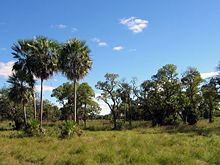Little pampas rabbit
| Little pampas rabbit | ||||||||||||
|---|---|---|---|---|---|---|---|---|---|---|---|---|

Kleine Mara, Tierpark Berlin |
||||||||||||
| Systematics | ||||||||||||
|
||||||||||||
| Scientific name | ||||||||||||
| Dolichotis salinicola | ||||||||||||
| Burmeister , 1876 |
The little pampas hare ( Dolichotis salinicola ), also known as the little mara or dwarf mara , belongs to the guinea pig family , even if the way it moves is reminiscent of a hare . There is a larger species in the genus of the Pampas hares , which essentially only differs in size. In the zoos , the small pampas hare is rarely seen compared to the large pampas hare ( Dolichotis patagonum ).
features
The small pampas hare resembles a hare, reaches a head body length of 45 to 50 cm and weighs about 4 kg. It does not have a white fur on its rump like the Great Pampas Hare.
distribution

The distribution area of the small pampas hare includes the Gran Chaco in southeastern South America in the states of Argentina , Bolivia and Paraguay . In Argentina it extends to the province of Cordoba in the south , in Bolivia only the extreme south belongs to this area. In the north of Argentina, the distribution area overlaps with that of the Great Pampas Hare.
As a resident of the Gran Chaco, the species prefers dry flat areas with thorn bush vegetation. The species occurs in natural, primary habitats as well as in modified, secondary habitats. The action area covers between 33.3 and 197.5 hectares, on average around 97.9 hectares.
Way of life
The little pampas hare grazes in small groups and moves forward, hopping like a hare. In contrast to the hare, however, it also has the ability to move around in the passageway . The long rear legs make it ideal for fast sprints, which it only does in an emergency. Then he takes refuge in his own dig or taken over by other animals in the earth cave, in which the diurnal animal not only retreats at night, but also raises its young there.
The females give birth to one to three young animals. The gestation period in captivity is 77 days.
Hazard and protection
The species is assessed by the International Union for Conservation of Nature and Natural Resources (IUCN) as "Least Concern" due to the size of the population and the large area of distribution. It is common within its range and there is no decline in the population that would pose a threat.
supporting documents
- ↑ a b c d e f Dolichotis salinicola in the IUCN Red List of Threatened Species 2011.2. Listed by: J. Dunnum, J. Vargas, N. Bernal, U. Pardinas, R. Ojeda, 2008. Retrieved March 5, 2012.
- ↑ Dolichotis patagonum in the IUCN Red List of Threatened Species 2011.2. Posted by: R. Ojeda, U. Pardinas, 2008. Retrieved March 5, 2012.
